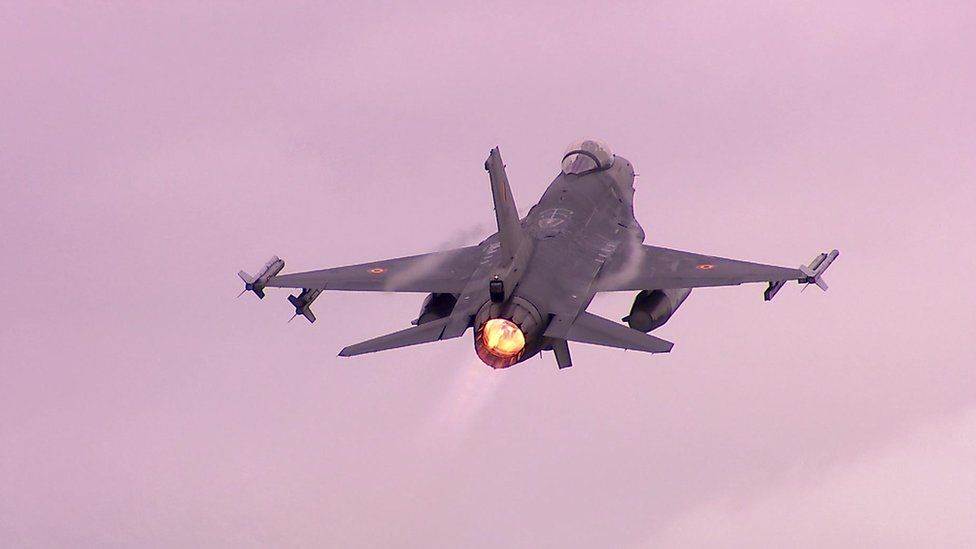ARTICLE AD BOX

The West now plans to train Ukrainian pilots on F16s. But when will they be able to use them in the war?
By Jonathan Beale
Defence correspondent, Norway
Western allies are set to announce their plans to train Ukrainian pilots to fly US-made F-16s when they meet in Brussels today. But it's still not clear which countries will be willing to provide the jets, how many, or even when.
Supplying Ukraine with F-16 fighter jets will "not be a silver bullet" or a "quick fix", says the head of Norway's Air Force. Maj Gen Rolf Folland says it'll take time for Ukraine to develop the ability to operate Western jets with complex weapons.
We meet at a large allied air exercise taking place over Norway, Finland and Sweden. It involves 150 fighter planes - many more than the entire Ukrainian Air Force.
Gen Folland says the training is about dominating the skies - to avoid what he calls the type of "old fashioned" conflict now taking place in Ukraine.
To gain supremacy of the air requires a level of scale and sophistication that Ukraine will not be able to replicate. Even providing a small fleet of F-16s could prove a major challenge.
It took Pulse, a Belgian pilot, three years to master his F-16 fighter. We've been asked to use his call sign, not his real name.
He shows us round his F-16, originally designed in the late 1970s, long before he was born.
"It flies like a dream", he says. "But flying is the easiest part. The rest is more difficult."
BBC
Flying is the easy part. The rest is more difficult
That includes learning to operate the F-16's radar, sensors and weapons. Ukraine, which currently has more pilots than aircraft, is hoping to compress that training into months.
Pulse sees the logic of providing Western jets to Ukraine. He points to his F-16's weapons: air-to-air missiles to destroy enemy aircraft, and bombs to hit targets on the ground. "That's important," says Pulse, "because you can use any weapons from Nato stocks with this jet."
But then there's the question of maintaining the jets.
The Norwegian Air Force, like others in Europe, has transitioned to the more modern F-35. So in theory there should be F-16s available for Ukraine.
At Orland air base they use two of their old F-16s to train aircraft engineers. That can take a year - even longer for a senior aircraft technician.
"You can't just hand over a fighter aircraft and say off you go!" Col Martin Tesli, the base commander and a former F-16 pilot, says.
He says there's a large logistical tail - spare parts, software and weapons. But he too understands the need to modernise Ukraine's fleet of old Soviet-era jets.
"At a certain point, if they're not provided with another aircraft, they won't have an air force to defend themselves."
BBC
You can't just hand over a fighter aircraft and say off you go!
Justin Bronk of the Royal United Services Institute says Ukraine would probably need the help of Western contractors to keep any F-16s flying. The obvious question, is what country is willing to accept the obvious risks of putting their own people on the ground?
Professor Bronk adds that Russia is only more likely to target Ukraine's air bases if it's supplied with Western jets. That's a danger for the single engine F-16, which has a large intake that can suck up debris from the runway.
These are good reasons why the US has, for so long, resisted pressure from Ukraine to provide F-16s. It's less about fears of escalation, and more about the practicalities of operating and maintaining the jets. The Pentagon has warned it'll be both complex and costly.
Ukraine has pleaded for Western fighter jets since the war began
Nor is providing Ukraine with Western fighters likely to significantly alter the battle on the ground.
Lt Col Neils Van Hussen, a former F-16 pilot of the Royal Netherlands Air Force, says "not a single weapons system will change a big war". F-16s, he believes, would simply give Ukraine "the ability to sustain what they're doing now".
The reality of this war is that even Russia, with its sizeable air force, has not been able to dominate the skies. Ground-based air defence systems are helping prevent that happening.
Providing Ukraine with more air defences will continue to be the immediate priority for the West. Rebuilding its air force is a longer term goal.

 1 year ago
24
1 year ago
24








 English (US)
English (US)